
Okhotsk Chapter
of the Wild Bird Society of Japan
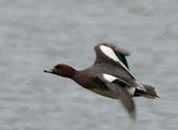
| Home | Events | Reports | Sightings | Checklist | Bird Guide |
| Birding Info | J Bird Names | References | Links | About Us | Contact Us |
| Sea of Okhotsk 2014 | Back to Reports Top | ||||
Though the objective of today's excursion was marine mammals rather than seabirds, I went along anyway because I love to be out on the sea and explore this completely different world. My objective was to see the remnants of drift ice and associated wildlife be they mammals or birds. The drift ice along the Abashiri coast first appears toward the end of January and stays until late March or so. This year, however, winter continued for another two weeks, the arrival of Tundra Bean Geese and Grey Herons at Tofutsu Lake was two weeks later than normal, and drift ice, still very dense in some areas and breaking apart into islands in areas closer to shore, continued to linger northwest of the Shiretoko peninsula.
 |
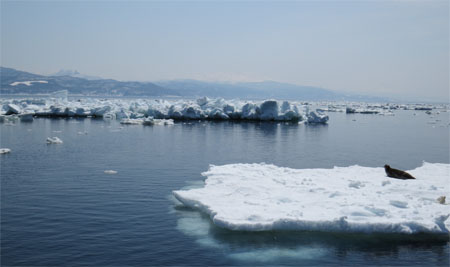 |
| The Shiretoko mountain range with Mt. Rausu (1,660 m) on the right, Mt. Iwo (1,562 m) on the left, and Mt. Shiretoko (1,254 m) at the far left, beyond remnants of drift ice on a beautiful calm sea. Temperature was around 3°C. | This is the first of four Ribbon Seals (Kurakake-azarashi), all females, we saw during the course of the trip, each on their own relatively flat island of ice. A closeup of this one is below, and another of the seals we saw is at the left. |
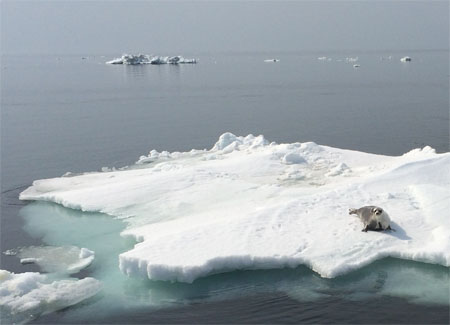 |
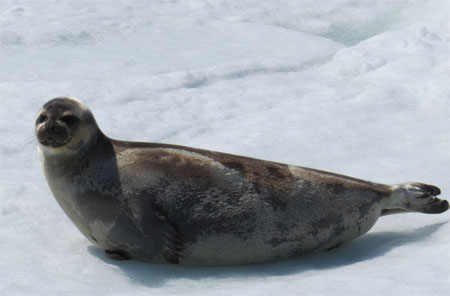 |
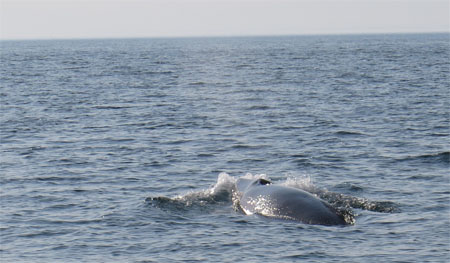 |
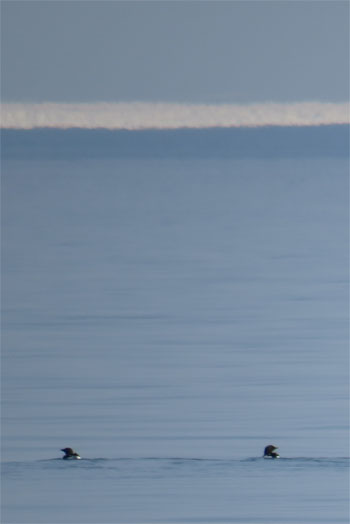 |
| Minke whales are very common in the Sea of Okhotsk. (Right) Thick-billed Murres (Hashibuto-umigarasu), in small groups almost everywhere we went today, are very common at this time of year. Dense drift ice in the background. Though they were in small numbers, another bird that we saw not far from the edge of drift ice was the Least Auklet (Ko-umisuzume). Thick-billed Murres and Least Auklets are both winter visitors. Some Rhinoceros Auklets (Utou) were around as well. |
Four days later, the Sea of Okhotsk was completely different. Seas were rougher, wind was up, sky mostly cloudy, and the drift ice was gone. Only the temperature was the same, 3°C. The most exciting change, however, was the arrival of tens of thousands of Short-tailed Shearwaters (Hashiboso-mizunagidori) on their remarkable 30,000-km migration that starts at their breeding grounds in southeastern Australia and roughly circumnavigates the Pacific in a clockwise direction before returning to Australia for the next breeding season. And the objective of the excursion this time was seabirds...
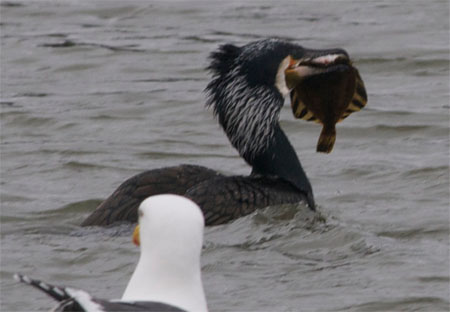 |
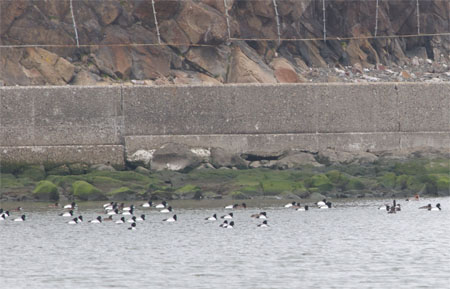 |
| A Great Cormorant (Kawa-u) in breeding plumage carries its catch, a Starry Flounder (Numa-garei), that also attracts the interest of a Slaty-backed Gull (Oo-seguro-kamome). The cormorant soon flies off with its catch. | Mostly Tufted Ducks (Kinkuro-hajiro) and a few Eurasian Wigeons (Hidori-gamo) and Greater Scaups (Suzu-gamo) at the base of Boushi-iwa, a large man-made rock at the entrance to Abashiri harbor. |
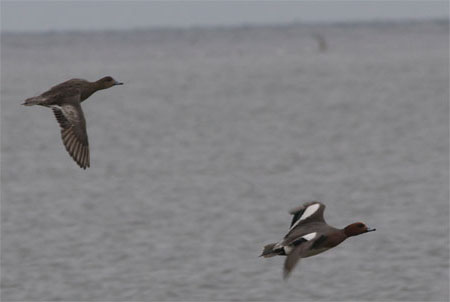 |
 |
| A pair of Harlequin Ducks (Shinori-gamo), also just outside Abashiri harbor. During winter, large numbers of Harlequins are in the seas offshore from Abashiri and Cape Notoro. They are also sometimes seen coming up the Abashiri River that passes through the city. | |
| A pair of Eurasian Wigeons as we leave Abashiri harbor (male on right). |
|
 |
|
| Black-headed Gulls (Yuri-kamome), some with summer plumage, others in transition from winter. Large groups of Black-headed Gulls have also been appearing at Tofutsu Lake. | |
 |
|
| It is not long before we see familiar scenes of Thick-billed Murres (Hashibuto-umigarasu) bobbing up and down on the waves, and diving almost simultaneously as we get closer. It is fun to see them emerge again nearby. By that time the speed of the boat has slowed and the birds are not disturbed. | |
 |
|
| A huge flock of Short-tailed Shearwaters (Hashiboso-mizunagidori; a.k.a. Muttonbird in Australia) in the distance. We saw several flocks like this during our time at sea. | |
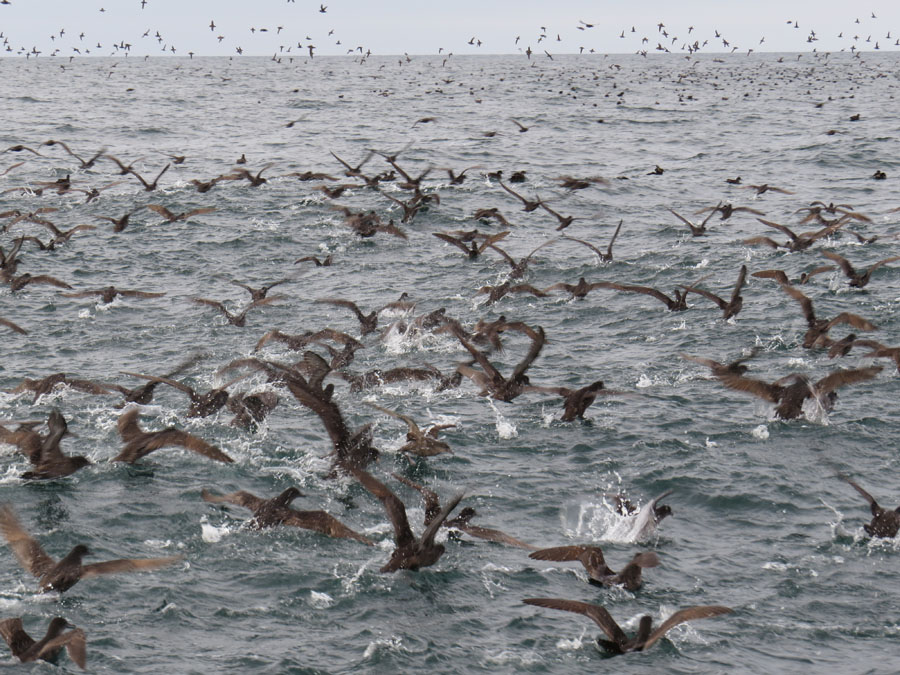 |
|
| The scene as we get closer to a flock at slow speed. | |
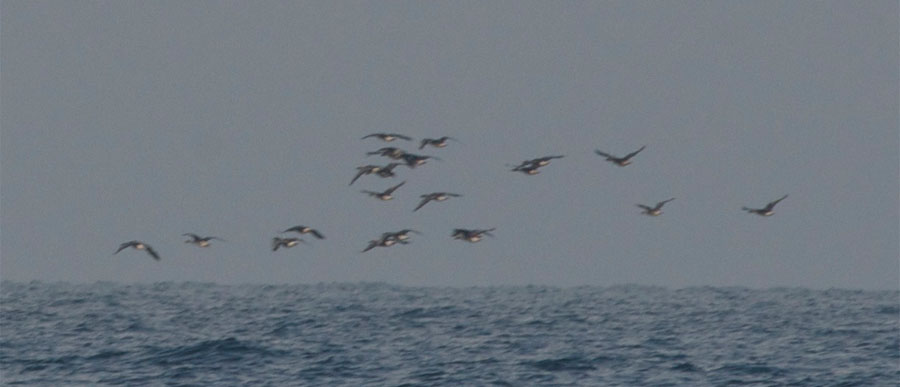 |
|
| A relatively small flock of Tundra Bean Geese (Hishikui) was seen in the distance flying close to the water surface. | |
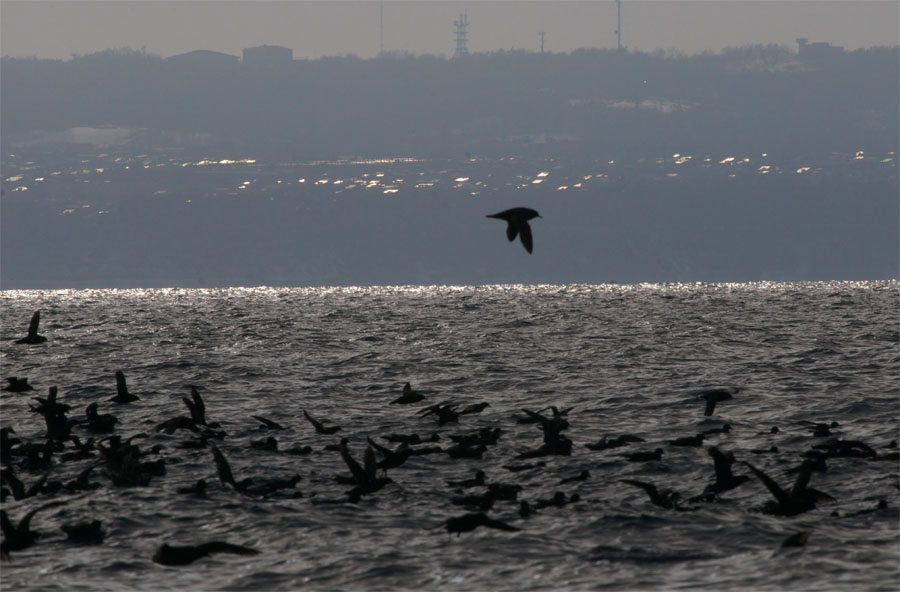 |
|
| On the way back to port at the end of the day is another flock of Shearwaters against a background of rays of sunlight on the sea and reflecting off remaining snow on land. | |
Our thanks go to Masayuki Miyamoto, our knowledgeable guide, and Captain Maeda of the Chipashiri.
Information about Abashiri Nature Cruises can be found on their webpage here (in Japanese) which is part of the Abashiri City Travel Site.
[Doug Braat]
| Mar | Apr | May | Jun | Jul | Aug | Sep | Oct | Nov | |
|---|---|---|---|---|---|---|---|---|---|
| Land | 5 | 20, 30 | 7 | 3 | |||||
| Sea | 5, 8, 15, 19 | 23, 26, 27 | 23 | 1 | 7 | 10, 31 | 14 |
